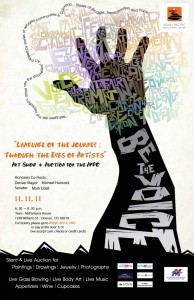 Here are several reasons to attend this Friday’s very cool “Language of the Journey – Through the Eyes of Artists” fundraiser for the Asian Pacific Development Center.
Here are several reasons to attend this Friday’s very cool “Language of the Journey – Through the Eyes of Artists” fundraiser for the Asian Pacific Development Center.
First, the project is a showcase of artists at Metro State College’s Department of Art, led by professor Carlos Fresquez, one of Denver’s most talented veteran painters and muralists. The art reception includes over 70 pieces from painting to jewelry, all up for auction.
Second, the artwork spotlights the experiences of Colorado’s multicultural refugee communities. The artists spent time and got to know local refugees from diverse locations such as Bhutan, Burma, Iraq, Sudan and Laos. You may have read in the past year about how Bhutanese and Burmese refugees have been attacked in Colorado, a sad irony since they came here to flee the violence and repression of their home countries. Colorado has welcomed refugees from all over the world for over 30 years. According to APDC, in 2010 alone, over 1,000 refugees from Burma, Bhutan, Nepal and Thailand came to Colorado.
Third, most of the proceeds from the artwork will go to the Asian Pacific Development Center. If you’re not familiar with it, APDC is a remarkable organization that’s provided culturally appropriate health and mental health and related services to the area’s Asian and Pacific Islander communities for over 30 years, including having interpreters on hand for immigrants who often have cultural values that prevent them from reaching out for help. APDC is in the midst of a capital campaign to raise $1.5 million for a new central facility to replace the three separate smaller locations the organization currently operates.
Fourth, Denver Mayor Michael Hancock and Colorado Senator Mark Udall are the co-hosts for “Language of the Journey – Through the Eyes of Artists,” and Hancock will be there to offer his remarks. It’s always cool to rub shoulders with Hizzoner, who follows in the footsteps of previous Mayor Hickenlooper in his support of both the arts and the Asian community.
Fifth, how can you resist the super-cool poster for this event? It has the emotional punch, dynamism and energy of classic 1950s and ’60s graphic arts with its funky type treatment and evocative upheld arm.
The event is 6:30-8:30 pm Friday, Nov. 11 at Tears-McFarlane House (1290 Williams St., Denver), which some of you may know as the headquarters for Capitol Hill United Neighborhoods, the folks who bring us the Capitol Hill Peoples Fair every year. Admission is $30 and you get to enjoy not just the artwork, but live glass blowing, live body art, live music, appetizers, wine and cupcakes — you know, the usual fundraiser stuff.
Be there or be square.






 Asian Americans are finally showing up in American pop culture at large, but Asian American fine artists are still mostly invisible. Only a few have had notable — or rather, noted — careers in the art world.
Asian Americans are finally showing up in American pop culture at large, but Asian American fine artists are still mostly invisible. Only a few have had notable — or rather, noted — careers in the art world. 





